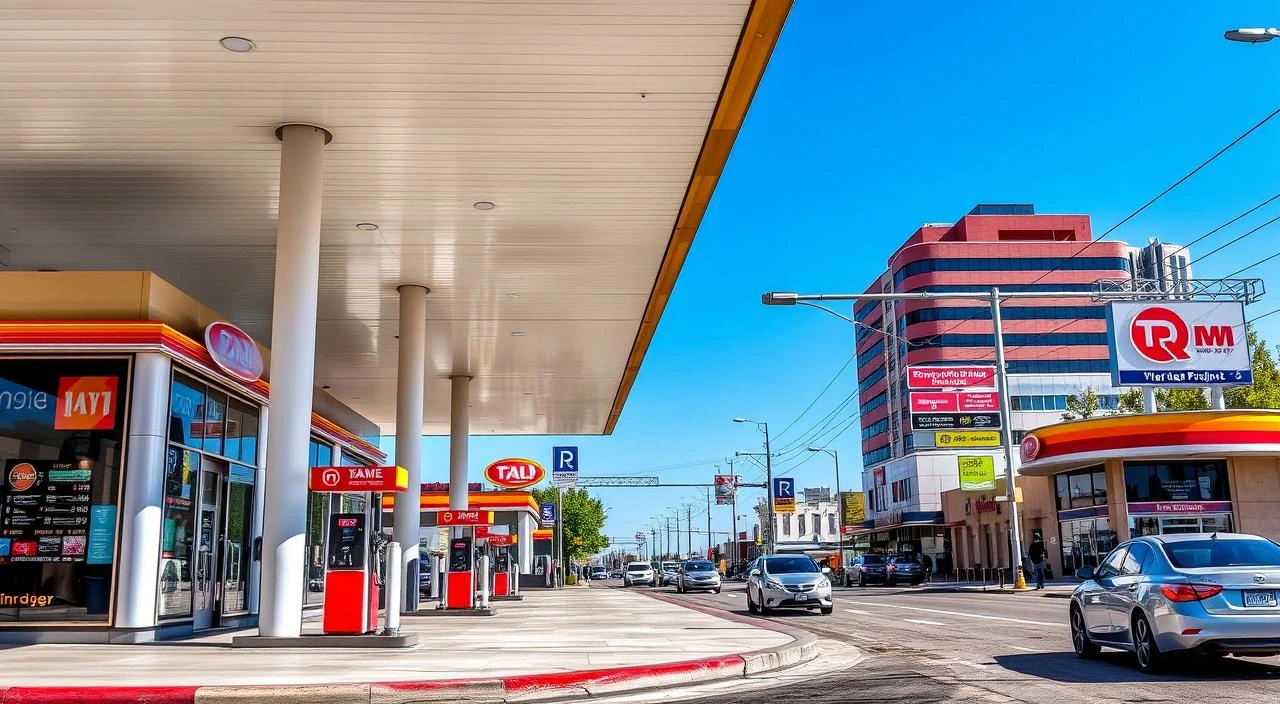Did you know there are over 100,000 gas stations in the U.S.? The oil and gas industry hit over $180 billion in 2018. It’s key to know the rules for businesses near gas stations.
We’ll look at zoning laws, environmental checks, and safety rules for businesses near gas stations. This info is great for business owners, gas station managers, or anyone interested in the topic. It offers deep insights into the world of businesses near gas stations.
Key Takeaways
- Understand the zoning regulations and proximity restrictions that govern the types of businesses that can be located near gas stations.
- Evaluate the environmental impact of gas stations and nearby businesses to meet regulations.
- Check if different business types fit with gas station operations and safety needs.
- Focus on public safety, like fire risks and how to avoid them, when planning near gas stations.
- Deal with the complex rules, like licenses and permits, to run your business legally and safely near a gas station.
Introduction
Gas stations have changed a lot. They now offer more than just fuel. Many have convenience stores, vehicle repair shops, and other services. This makes life easier for people, but it also raises important questions about zoning, safety, and how well these services work together.
The Importance of Understanding Regulations and Safety
When setting up businesses near gas stations, knowing the rules and safety issues is key. Laws about commercial zoning and how far apart buildings must be are important. Studies on the environment and how well businesses fit in help make sure everything is safe.
Knowing these rules helps everyone make smart choices. It ensures that economic growth doesn’t come at the cost of safety. This balance is important for the community’s well-being.
- Gas stations are increasingly integrating with convenience stores, vehicle repair facilities, and other services
- Zoning regulations and safety considerations play a critical role in determining what types of businesses can be located near gas stations
- Commercial zoning laws govern the permissible uses and setback requirements for gas stations and nearby establishments
- Environmental impact assessments and compatibility assessments help ensure proposed businesses are compatible with gas station hazards and risks
- Understanding regulations and assessments is essential for making informed decisions about the placement and design of gas station-related businesses
“By understanding the regulatory landscape and compatibility assessments for locating businesses near gas stations, we can ensure these establishments can operate safely and effectively without negatively affecting the surrounding area.”
Zoning Regulations and Proximity Restrictions
Understanding commercial zoning laws and proximity restrictions is key for businesses near gas stations. In California, the Business and Professions Code sets rules for gas station locations and nearby businesses.
Commercial Zoning Laws Governing Gas Station Locations
California’s zoning laws range from MR1 to M3 for industrial areas. MR1 zones mix light industrial with commercial, acting as buffers. M3 zones are for heavy industrial, far from homes to lessen noise and pollution.
Commercial zoning includes retail, office, and restaurant areas, each with its own rules. Zones are divided into Residential, Commercial, Industrial, Mixed-Use, and Special Districts, each with its purpose.
Setback Requirements for Businesses Near Gas Stations
There are setback rules for gas stations and other businesses. These rules help prevent risks like fires and spills. They protect the environment and public safety.
Businesses near gas stations must follow these rules to avoid safety issues. The exact distance needed varies by location and business type.
Following these laws and rules is vital. It ensures gas stations and nearby businesses are safely placed. This protects everyone and the environment.
Environmental Impact Assessments
When thinking about placing businesses near gas stations, it’s key to look at environmental impact assessments. These studies check how fuels are stored and handled. They also look at the chance of spills or leaks and how they might harm soil and water.
These assessments help decide if certain businesses can go near gas stations. They also show how to protect the environment and public health.
Industry data shows over 7,000 Phase I Environmental Site Assessments have been done. Costs range from $1,500 to $5,000 for commercial properties. Prices vary based on the property’s location, past use, and size.
The Phase I assessment is the first step. It looks for recognized environmental conditions (RECs) that might need more study in a Phase II assessment.
If a Phase I finds RECs, a Phase II study is needed. This study takes about four weeks. It costs between $5,000 and $25,000, depending on what’s needed.
The Phase II study aims to find out how bad any contamination is. This info is key for making decisions and finding ways to fix problems.
Ignoring environmental risks can lead to big cleanup costs. This can hurt a business’s money, cash flow, and property value. So, knowing the environmental risks near gas stations is very important for businesses.
“Completing thorough environmental impact assessments is a vital step in ensuring the long-term sustainability and viability of businesses located near gas stations.”
Compatibility Assessments
When setting up businesses near gas stations, it’s key to check if they’re safe. These checks look at how well different businesses fit near gas stations. They look at fire risks, dangerous material storage, and how safe they are for everyone.
Local authorities use these checks to decide where and how businesses can be near gas stations. This helps avoid accidents and keeps the community safe. They consider the gas station’s special needs, like fuel storage, to find the best businesses to have nearby.
Evaluating Fire Hazards and Hazardous Material Risks
Fire risks are a big part of these checks. Some businesses, like those with flammable materials, can be more dangerous near gas stations. The checks make sure these risks are managed well.
They also look at how businesses handle and store dangerous materials. Businesses with these materials must follow strict safety rules. They must also be ready to handle spills or leaks to keep everyone safe.
| Business Type | Compatibility Assessment Considerations |
|---|---|
| Automotive Repair Shops | Flammable materials, hazardous waste disposal, fire risk |
| Retail Stores | Crowd management, emergency evacuation, fire safety |
| Restaurants | Cooking equipment, ventilation, fire suppression systems |
| Warehouses | Storage of hazardous materials, fire prevention, emergency response |
By carefully checking how well different businesses fit near gas stations, local authorities keep everyone safe. They make sure there are no big fire hazards or other dangers from being near fueling operations.
Public Safety Considerations
Keeping people safe is key when businesses are near gas stations. These places are close to things that can start fires and have dangerous materials. So, it’s important to have good safety plans and know how to act in emergencies.
Local rules often require things like fire systems, evacuation plans, and training for staff. These steps help protect everyone, including customers and the community around.
Fire Hazard Risks and Mitigation Measures
Gas stations can be dangerous because of the flammable fuels and possible fire starters. Businesses near these places need to take steps to reduce these risks. This includes fire systems, emergency exits, and training for staff.
Following local fire rules and taking these steps is vital. It keeps employees, customers, and the community safe.
| Statistic | Value |
|---|---|
| Approximate percentage of gas station accidents caused by vehicle movement | Common cause of injuries at gas stations |
| Percentage of gas stations that experience fire and explosion risks | Considerable risk wherever gasoline is present |
| Statistic on the prevalence of manual handling injuries at gas stations | Often overlooked workplace hazard |
| Percentage of slips, trips, and falls at gas stations related to spilled fuel and oil | Significant hazard to be addressed |
| Ratio of incidents of violence and robberies at gas stations due to high cash flow and quick entry/exit options | Factors contributing to robberies |
| Data on the risk of explosion in compressed air systems leading to potentially damaged tires | Requires respectful handling due to possible dangers |
These numbers show the safety issues near gas stations. From accidents to fire risks, there are many challenges. But with the right steps, we can keep everyone safe.
can any business be located next to a gas station
Can any business be near a gas station? The answer is not simple. It depends on local rules and how well a business fits in.
Local officials check if a business is right for the area. They look at fire risks, hazardous materials, and how it affects safety. Zoning rules and checks are key to see if a business is good for a spot near a gas station.
Some businesses might work near a gas station, but others might not. The aim is to balance business growth and safety. This ensures businesses near gas stations can operate safely and responsibly.
| Factors Considered | Potential Impacts |
|---|---|
| Fire Hazards | Businesses with flammable materials might not be allowed near gas stations because of fire risks. |
| Hazardous Materials | Businesses with hazardous chemicals face extra rules to keep everyone safe. |
| Public Safety | Officials think about traffic, pedestrian safety, and emergency access when deciding if a business is okay near a gas station. |
In short, placing a business next to a gas station is not easy. Local rules, checks, and safety must be considered. This ensures gas station-related businesses are placed responsibly and safely.
“Businesses near gas stations need to consider better deals, loyalty programs, and discounts to attract and keep customers.”
Land Use Planning
Land use planning is key in deciding where to put gas stations and other businesses. Local officials must weigh the benefits of these places against the need to keep people safe and the environment clean. They also need to think about the community’s character.
This balance requires looking at zoning laws, doing detailed impact studies, and talking to the community. This way, gas stations and related businesses fit with what the community wants.
Zoning Regulations and Community Considerations
Rules for where gas stations can go often include how close other businesses can be. The Handbook suggests not placing new sensitive uses too close to big gas stations. A big gas station is one that moves 3.6 million gallons a year or more.
Also, maps showing air pollution risks can help officials decide on gas station locations.
Balancing Economic Development and Public Interest
Economic growth is important, but so is keeping people safe and the environment clean. Local governments might change zoning rules to meet community needs. They make sure businesses near gas stations are safe and fit well.
“The power to zone is part of the police power and is used to regulate the conduct of individuals towards one another and the use of their property.”
By carefully planning land use, communities can grow economically while protecting their people and environment.
- COIN Stock Price Prediction: What’s Next for Coinbase?
- Boost Organic Visits for Google Business Profile
Fuel Storage Safety
Keeping fuels safe at gas stations is key to protecting our environment and keeping people safe. Rules and best practices guide how fuel is stored, from underground tanks to spill management. This ensures everything is done right.
Underground Storage Tanks
Underground tanks can go as deep as 55 feet and hold up to 30,000 gallons. They’re less likely to harm the environment than aboveground tanks. But, they need careful upkeep and regular checks to avoid problems like water and rust.
Portable Fuel Containers
Portable containers like metal drums and plastic cans are handy for moving fuel around. But, they must be handled carefully to avoid spills and leaks. These can be dangerous for the environment and people. Flexible fuel bladders, though easy to carry, might be more at risk for these issues.
Safety Protocols and Regulations
- Follow all safety rules and laws to avoid accidents and keep a safe work area.
- Put in fire suppression systems, like sprinklers, to handle emergencies.
- Use advanced leak detection and monitoring to catch and prevent fuel spills early.
By focusing on fuel storage safety, gas station owners can protect our environment and keep communities safe. Following rules and using the best practices is vital to reduce risks in fuel storage and handling.
Gas Station Setbacks
Zoning rules often have strict setback requirements for businesses near gas stations. These rules set a minimum distance between gas stations and places like homes, schools, and parks. The goal is to reduce risks like fires, spills, and pollution.
Commercial zoning laws require specific setbacks. For example, gasoline pump areas must be 25 feet from streets. Auto service buildings need to be 40 feet away. There’s also a 15-foot planter area next to public streets, except for driveways.
| Setback Requirement | Minimum Distance |
|---|---|
| Gasoline pump islands, canopies, and related facilities | 25 feet from any street right-of-way or official plan line |
| Auto service buildings | 40 feet from the street right-of-way lines |
| Planter area adjacent to property line along a public street | 15 feet wide, with exceptions for approved driveways |
Businesses near gas stations must follow these proximity restrictions to avoid problems. Not following zoning rules can lead to legal trouble and harm the community.
Knowing about gas station setbacks and zoning regulations helps businesses choose the right location. This ensures they operate safely and responsibly, with less impact on the community.
Business Ideas Near Gas Stations
Starting a business near gas stations can be challenging. But, there are many opportunities to explore. By understanding the pros and cons, entrepreneurs can find great ideas. These ideas can help the local economy and meet community needs.
Convenience Stores and Grocery Shops
Convenience stores fit well near gas stations. They offer quick snacks and drinks to drivers. Grocery shops or small markets can also be a good match. They provide fresh food and household items.
Vehicle Repair and Maintenance
Vehicle repair services are another good idea. They can offer oil changes and tire rotations. This is convenient for drivers already at the gas station. It helps build a loyal customer base.
Diversifying with Complementary Services
Gas station owners can also consider other services. Car washes, pet grooming, and cleaning services are options. Even small food trucks or specialty shops can work. Diversifying can attract more customers and boost the local economy.
To succeed near gas stations, it’s important to follow the rules and understand the area. Identifying the right opportunities is key. With a good plan and great customer service, entrepreneurs can thrive in these locations. This can help the whole region grow economically.
| Business Idea | Potential Benefits | Startup Costs |
|---|---|---|
| Convenience Store | High foot traffic, diverse product offerings | $100,000 – $500,000 |
| Vehicle Repair and Maintenance | Convenient location for customers, consistent demand | $50,000 – $200,000 |
| Food Truck | Low overhead, flexibility, high revenue | $30,000 – $100,000 |
| Pet Grooming | Steady demand, low competition in small towns | $10,000 – $50,000 |
Licensing and Permitting Requirements
If you want to start a business near a gas station, you must understand the rules. You’ll need to get licenses and permits. This includes registering with the California Department of Tax and Fee Administration (CDTFA) for a seller’s permit. You might also need underground storage tank permits and other specific licenses.
It’s important to follow these rules to run your business legally and safely. To make things easier, consider using a service like OWL. They handle all the permits for petroleum and electric charging services, covering local, state, and federal laws.
Navigating the Regulatory Landscape
Businesses near gas stations face many rules. Convenience stores, fueling operations, and fleet operators need zoning, signage, and ADA permits. They must also follow safety codes, local laws, and get food and beverage licenses. OWL’s VAULT software helps manage permits and keeps track of inspections and compliance.
- OWL gets all permits for fuel storage and disbursement to meet EPA rules.
- Fleet operators face the same standards as retail fueling and charging operations for fuel storage and electric vehicle charging.
- OWL supports electric mobility projects by securing necessary permits.
- OWL’s teams handle annual inspections from regulatory agencies and OSHA to prevent disruptions.
Dealing with all these rules can be hard and take a lot of time. But, with a service like OWL, you can make sure you have the right licenses and permits. This way, you can run your business safely and legally near a gas station.
“Specialized electrical expertise is essential for convenience stores, fueling stations, and fleet operators in building and maintaining fueling centers.”
Conclusion
Finding the right spot for businesses near gas stations is key. It’s all about balancing economic growth, public safety, and protecting the environment. Knowing the rules, like zoning laws and safety standards, helps everyone involved.
Using tools like Polygon AI can help you make smart choices about where to put your gas station. It’s important to follow the rules for licenses and permits. This ensures your business fits in with the area’s needs and laws.
Gas stations and nearby businesses can work well together if done right. Planning carefully and focusing on safety and the environment is essential. This way, your gas station and other businesses can help the community grow and thrive.
FAQ
What are the zoning regulations and proximity restrictions for businesses located near gas stations?
Zoning laws control where gas stations can go and what businesses can be nearby. These rules often have setback requirements. This means gas stations must be a certain distance from homes, schools, and parks.
How do environmental impact assessments evaluate the environmental risks of gas stations?
These assessments look at how gas stations handle fuels and the risk of spills. They check if soil and groundwater could get contaminated. This helps decide if certain businesses can safely be near gas stations.
What are the key considerations for assessing the compatibility of businesses near gas stations?
Assessments look at fire risks, hazardous materials, and safety. They help local authorities decide where and how businesses should be placed near gas stations.
How do public safety considerations factor into the placement of businesses near gas stations?
Safety is key near gas stations because of fire risks. Businesses must have safety plans and training. This includes fire systems and knowing how to respond in emergencies.
Can any business be located next to a gas station?
It depends on local laws and assessments. Some businesses are okay, but others might not be due to safety and environmental concerns.
How does land use planning impact the placement of gas stations and nearby businesses?
Planning balances economic benefits with safety and environmental needs. It considers zoning, impact assessments, and community input. This ensures the area stays safe and attractive.
What are the key regulatory requirements for the safe storage and handling of fuels at gas stations?
Rules cover tank design, construction, and maintenance. They also handle fuel spills and leaks. Following these rules is critical for safety and environmental protection.
What are some common business ideas that can thrive near gas stations?
Convenience stores and repair shops can do well near gas stations. They attract customers and boost the local economy. Understanding regulations and doing assessments helps businesses find safe and successful spots.
What licenses and permits are required for businesses operating near gas stations?
Businesses need various licenses and permits. This includes a seller’s permit from the CDTFA and underground storage tank permits. They must also get specific permits for their business type.

My name is Jakir, I am a content writer, content creator, I give business, sports, finance, trending news and I have 10 years of experience in this and this is my blog goldennews24.com.










